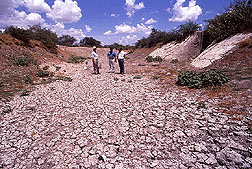This page has been archived and is being provided for reference purposes only. The page is no longer being updated, and therefore, links on the page may be invalid.
|
|
An Online Check on the Weather and the Water Table
By Luis PonsMay 19, 2005
Agricultural Research Service (ARS) geologist John Daniel and colleagues believe online, real-time, groundwater-depth data can inform Oklahoma residents about drought conditions.
That's why Daniel and cooperators have launched a pilot study to see if it's feasible to offer localized water-table readings through an existing statewide meteorological network. Daniel, at the ARS Grazinglands Research Laboratory in El Reno, Okla., is working with Noel Osborn of the state's Water Resources Board, and Chris Fiebrich of the Oklahoma Climatological Survey (OCS).
The network, called Oklahoma Mesonet, comprises more than 110 automated weather stations. Run by OCS and supported by the University of Oklahoma and Oklahoma State University, it provides data on air temperature, wind, rainfall, humidity, solar radiation and soil temperature.
The project, which is being funded by the U.S. Bureau of Reclamation, is focused on two groundwater observation wells that have been drilled at existing Mesonet stations. One of the wells is located at the El Reno laboratory. The second well is located in Acme in the Little Washita River Experimental Watershed, where ARS scientists have conducted research since the 1960s.
The water level at the El Reno site is between 15 and 20 feet below the surface, while water at the Acme site is found at 45 to 50 feet down.
Measurements at the wells, collected in conjunction with 20 other meteorological variables, will help interpret water level changes and explain the impact of drought on groundwater supply, according to Daniel.
The real-time data can be viewed on the Web. At Mesonet's data page (http://www.mesonet.org/public/), first download and install the WxScope plug-in software. Then return to the data page and click the left-hand links for "Interactive Products" and "Graphs (Ground Water)."
Daniel, who is in the laboratory's Great Plains Agroclimate and Natural Resources Research Unit, explained that the data can assist farmers, ranchers, water managers and planners to meet the state's agricultural water needs, mitigate potential losses associated with drought and a variable climate, promote sustainable use of water resources and enhance regional economic stability.
ARS is the U.S. Department of Agriculture's chief scientific research agency.

